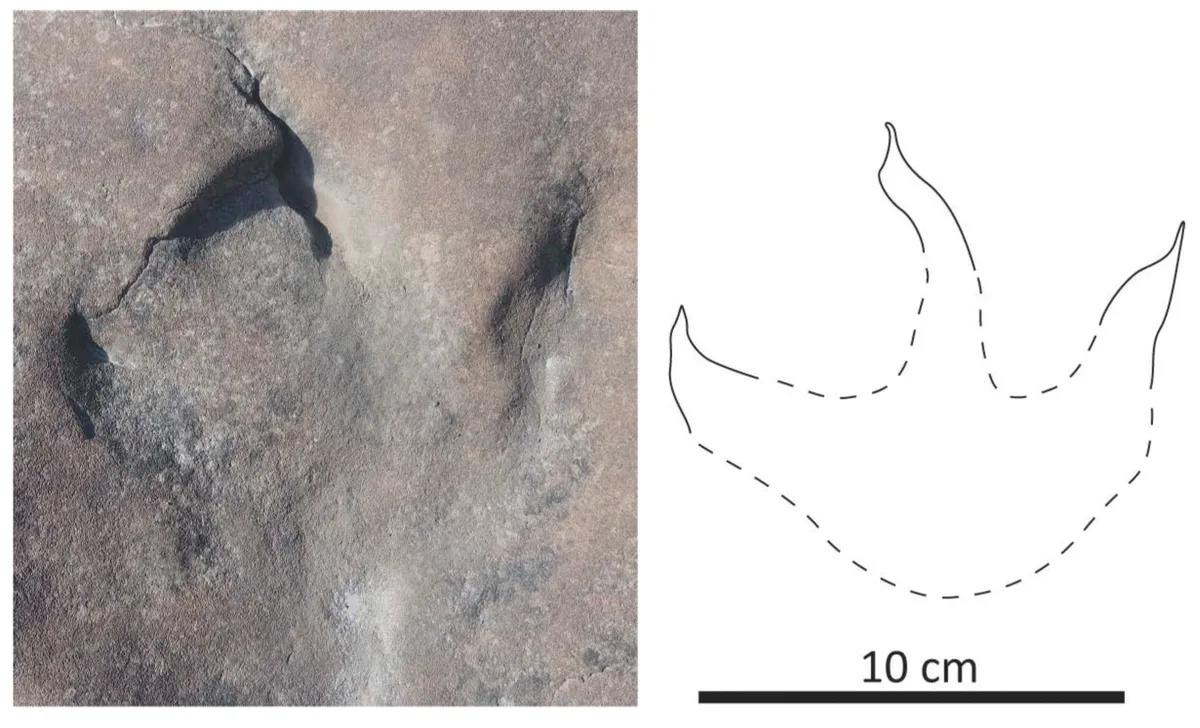Scientists in Alaska have found a remarkable set of dinosaur tracks, fossilised plants and tree stumps in the far north-west of the American state.
The discovery, published in Geosciences, sheds new light on climate and movement of animals near the time when they began travelling between Asia and North America roughly 100 million years ago.
The find is particularly significant as it corresponds to the emergence of the Bering Land Bridge, an expanse of land that once connected the two continents, says the study.
- Giant prehistoric sea lizard with dagger-like teeth discovered in Morocco
- Megalodon: the super-shark that could swallow killer whales whole but didn't like the cold
- Giant pre-historic worms discovered in Greenland

The research was led by palaeontologist Anthony Fiorillo, executive director of the New Mexico Museum of Natural History and Science, alongside an international team of scientists, including geology professor Paul McCarthy from the University of Alaska Fairbanks.
“We've had projects for the last 20 years in Alaska trying to integrate sedimentology, dinosaur palaeontology and the palaeoclimate indicators,” says McCarthy.
“We’ve done work in three other formations — in Denali, on the North Slope and in Southwest Alaska — and they're about 70 million years old.”
“This new one is in a formation that's about 90 to 100 million years old."
“It was just like we were walking through the woods of millions of years ago."
Fiorillo notes the importance of the age: "What interested us about looking at rocks of this age is this is roughly the time that people think of as the beginning of the Bering Land Bridge — the connection between Asia and North America. We want to know who was using it, how they were using it and what the conditions were like."
According to the paper, research into the palaeoclimate can help scientists understand global warming today.
“The mid-Cretaceous was the hottest point in the Cretaceous,” says McCarthy. “The Nanushuk Formation gives us a snapshot of what a high-latitude ecosystem looks like on a warmer Earth.”
The Nanushuk Formation is a thick outcropped layer of sedimentary rock, which dates to roughly 94 million to 113 million years ago in the mid-Cretaceous Period – around the time when the formation of the Bering Land Bridge began.

Walking into the past
During the fieldwork, which took place in 2015–2017, the team found approximately 75 dinosaur tracks (along with other related indicators) on Coke Basin, a geologic feature of the Nanushuk Formation.
“This place was just crazy rich with dinosaur footprints,” says Fiorillo.
"Research into the palaeoclimate can help scientists understand global warming today."
The researchers were particularly intrigued by one site where an ancient landscape revealed itself through fossilised trees, tracks and faeces.
“We were at a spot where we eventually realised that for at least 400 yards we were walking on an ancient landscape,” says Fiorillo.
“On that landscape we found large upright trees with little trees in between and leaves on the ground. We had tracks on the ground and fossilised faeces.”
“It was just like we were walking through the woods of millions of years ago."
- How were dinosaur footprints preserved?
- Fossils guide: how they’re formed, where to find them and whether it’s ok to keep them
- Best dinosaur documentaries to watch
Abundance of birds
“One of the things we did in our paper was look at the relative frequencies of the different kinds of dinosaurs,” says Fiorillo. “What was interesting to us was that the bipedal plant eaters were clearly the most abundant.”
The paper says that 59% of the total tracks discovered belonged to two-legged plant eaters and 17% were four-legged plant eaters. Meanwhile, birds accounted for 15% and non-avian, mostly carnivorous, bipedal dinosaurs were 9%.
“One of the things that was interesting is the relative frequency of bird tracks,” Fiorillo says. He points out that nearly half of North America’s shorebirds breed in the warm months of today’s Arctic. The bird tracks along the Kukpowruk River indicate that the warm paleoclimate may have similarly influenced bird populations during the Cretaceous Period, suggests the study.
“The samples we analyzed indicate it was roughly equivalent to modern-day Miami. That’s pretty substantial.”
Exotic Alaska
Carbon isotope analysis of wood samples provided insights into precipitation levels, indicating an annual rainfall of about 70 inches, supporting global precipitation patterns associated with the Cretaceous Thermal Maximum (a long-term trend approximately 90 million years ago when average global temperatures were significantly higher than those of today).
“The temperature was much warmer than it is today, and what’s possibly more interesting is that it rained a lot,” says Fiorillo.
“The samples we analysed indicate it was roughly equivalent to modern-day Miami. That’s pretty substantial.”
McCarthy’s role as a fossil soils expert was to interpret the type of environment that existed at the time: “We can say here's a river channel, here's a flood deposit, here's a levee, here's the floodplain, here's a swamp. And so if we're able to find tracks in that section, then you can sometimes say that a group of dinosaurs seems to have really liked being here as opposed to there.”
Despite these revelations, Fiorillo emphasises that there is still much more to uncover.
“This puts a new dot on the map and tells us there's a lot here, and it fits into the bigger picture,” he says. “The big picture is we're trying to get better resolution on what life was like in the high latitudes back at the time the dinosaurs were roaming around.”
Find out more about the study: New Dinosaur Ichnological, Sedimentological, and Geochemical Data from a Cretaceous High-Latitude Terrestrial Greenhouse Ecosystem, Nanushuk Formation, North Slope, Alaska
More prehistoric discoveries
- Why were prehistoric insects so large?
- Dinosaur mass extinction: what caused it, which dinosaurs went extinct, and how mammals survived
- Why did dinosaurs get so big?
- Five British dinosaurs you've (probably) never heard of
Main image credit: Fiorillo et al., Geosciences 2024
